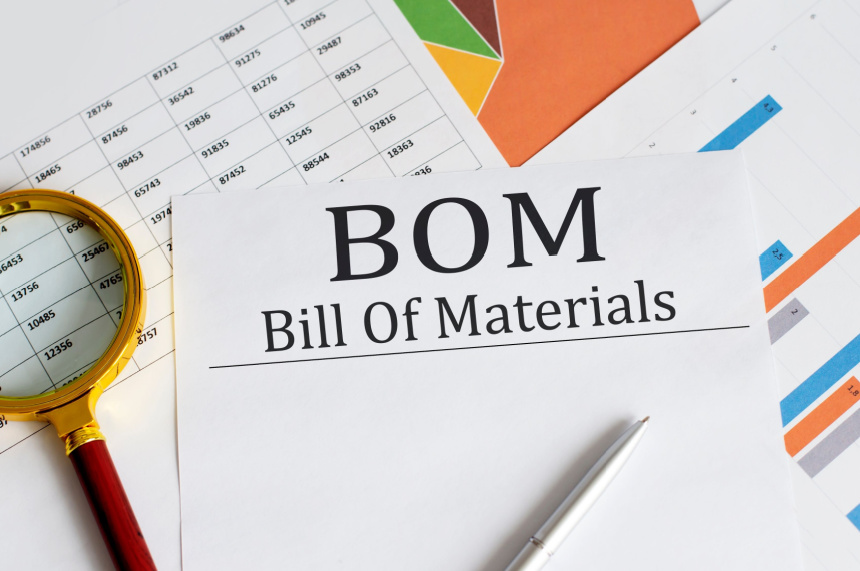Bill of Materials (BOM) - What it is and what are the types?
Business | September 05, 2022 | By
What is a Bill of Material (BOM)?
What’s the first thing you do when you want to buy grocery items? You make a list. It could be a list of ingredients you need to cook that delicious roast or a list of household items. The same applies to product manufacturing companies also. To manufacture the end product, which comprises multiple components (or ingredients), they need structured lists of items in sequential order so there is no confusion about what goes into making a product or what doesn’t. The more complex the end product, for example, a blasthole drill used in mining or a rocket used for carrying satellites, the more extensive the list of components or parts.
Just as there is a cooking procedure you would follow, there are standard procedures for manufacturing, assembly, servicing, etc. And a list containing all of the above is called a Bill of Material (BOM).
So, to technically define the term, Bill of materials, BOM, associated list, or product structure is a comprehensive list of the raw materials, components, sub-components, and sub and intermediate assemblies. A BOM specifies the part number and description, UOM, quantity of each item required to manufacture one unit of the end product, etc. And a BOM also contains instructions or a list of sequential steps to manufacture, assemble and even service a component or end product. There is typically a hierarchy in BOMs. The main assembly is at the top, followed by sub assemblies, components/parts, and materials.
While the idea of a BOM is simple, creating, managing, and maintaining the accuracy of BOMs are challenging, especially for products with hundreds of parts. It may become necessary to modify some of the components or parts in the BOM if suppliers are unable to meet deadlines or if customers want a change in material or design.
 The Key Elements of a Bill of Material (BOM)
The Key Elements of a Bill of Material (BOM)
Given the vast and complex information in a BOM, creating a BOM requires inputs from across the company. The major teams involved in creating a BOM include design and engineering, procurement, production, and costing. A BOM consists of the following key elements.
-
BOM level
A BOM level is a number that denotes the level at which each part, assembly, or sub-assembly fits within the complete BOM hierarchy. In an electric vehicle (EV), there are multiple components, such as the battery pack, chassis, body frame, doors, interior, seats, etc. And each will either have a sub-assembly of its own, belong to a sub-assembly, or have both. Generally, in most cases, the end product will be at level 0, the sub-assemblies will be at level 1, the next-level sub-assemblies will be at level 2, and so on.
-
Part Number
A part number is a unique number assigned to an end product, sub-assembly, and part/component. The naming system depends on the organization and is unique to every organization.
-
Part Name and Description
Similar to a part number, part name and description are also unique to every part. The part name tells us what the part is about and the part description provides more details about the part/component. For example, a part description for a simple screw, ‘SST VENTED SOCKET HEAD CAP SCREW #4-40 UNC-3A X 0.625 LONG’
-
Quantity
Quantity indicates how many units of that particular part or component are there in the assembly or sub-assembly. For example, a four-cylinder engine contains four pistons.
-
Procurement type
This indicates whether a part is procured from suppliers or manufactured in-house.
-
BOM notes
In the notes section, any other useful information which will be helpful is added. For example, regarding the adhesives to be used, material specifications, etc.
Now that we have seen the contents of a BOM, let us look into the types of BOM.
Types of Bill of Materials (BOM)
Based on the BOM structure, BOMs can be classified into two types:
Single-Level BOM
A single-level BOM is similar to a shopping list. Here, we can view the parts or components that go into making a product and their quantities. While it is easy to create a Single-level BOM, there is a drawback, they do not show the relationships between the various components, assemblies, and sub-assemblies. And if there is a failure in the product, it is difficult to identify the item that requires service or needs replacement. Hence, single-level BOMs are used only for simple products.
Multi-Level BOM
While multi-level BOMs require more work creating, they show all the parts of the end product. They also show the parent-child relationships between the parts, assemblies, and sub-assemblies.
There are also different types of BOMs based on functionality. Here are a few key ones:
Manufacturing Bill of Material (MBOM)
The manufacturing bill of materials (MBOM) contains the items that go into making a final manufactured and shippable product. In the MBOM, you will also find details about the parts that require processing before they reach the final assembly stage. It also explains how every component relates to one another.
The first half of the MBOM is known as the production BOM. It is the foundation for the production order. It contains the structured list of parts and assemblies in the production of the parent product.
Assembly BOM forms the second half of the MBOM. They are the master data and define the parts that go into an assembled item and the resources needed to assemble the assembly items.
Engineering Bill of Materials
An engineering bill of materials, referred to as the ‘as designed’ bill of materials, reflects the end product designed by design and engineering teams. EBOMs consist of technical drawings of the product. It is common to have more than one version of EBOM for a product as the designs usually go through several iterations before teams arrive at a final design.
Sales Bill of Materials
Sales BOMs list the products and components required by customers to develop their products. In addition to the finished product, it includes the components, as they appear in the sales record.
Configurable Bill of Materials
A configurable BOM (CBOM) is a type of BOM in product manufacturing companies use to create BOMs for products that have multiple options.
Make the most of BOMs using Source-to-Pay software
In product manufacturing companies, procurement and sourcing teams receive the BOMs from the engineering teams once a design is finalized. And based on the commodity, buyers are assigned to various parts. But, the problem here is that when there are revisions to the design, procurement teams are in the dark unless the engineering teams share the information. This leads to several problems. A supplier might have begun production for a particular item, whose design was revised. Taking proactive measures would have been possible had the information been relayed to procurement teams at the earliest opportunity. What procurement teams need is software that integrates with PLM and ERP and shares data seamlessly across platforms and makes data available to all stakeholders. At Zumen, this is just one of the procurement challenges we address. To learn more about how you can strategize your procurement and sourcing operations feel free to contact us at [email protected] or schedule a free demo.













 The Key Elements of a Bill of Material (BOM)
The Key Elements of a Bill of Material (BOM)


